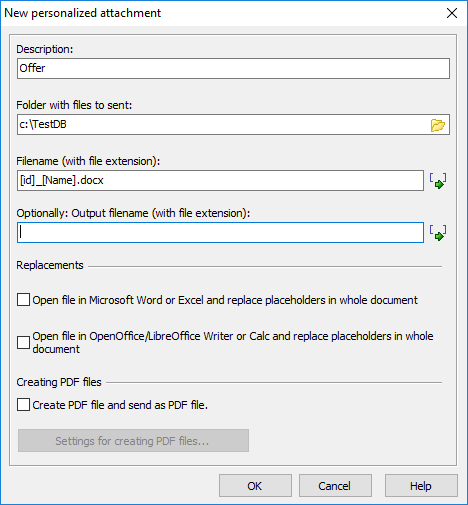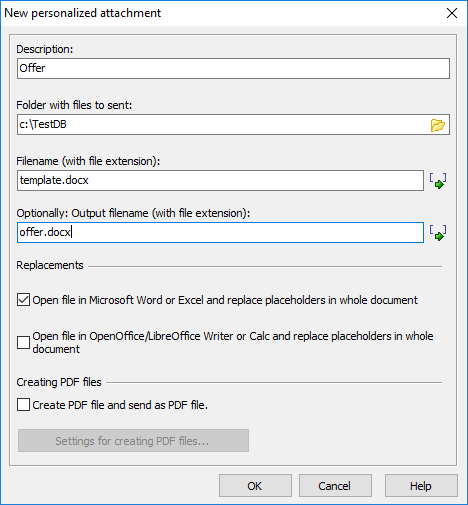
Personalized attachments can be used to send every recipient a different attachment. SuperMailer can create a file with information stored in the recipient list for every recipient. It can also replace placeholders in Office files (Microsoft Word, Excel or OpenOffice/LibreOffice Writer/Calc) or in text based files.
Sending emails with personalized attachments takes more time because every email has to be encoded separately. Normal attachments should be preferred, so don't use personalized attachments as substitution for normal attachments.
Properties of personalized attachments
| Unique name | Use an unique name for every personalized attachment. This
name should not be used in the list of all the recipients, for text blocks
or functions.
|
| Attachment for recipient group | You can select a recipient group for which attachment should
be send.
|
You can create personalized attachment with Office files or self construct a text based file.
| Folder with files to send | Select the directory which contains files which should be
send. You have to fill in this information.
|
| Filename | Please define a rule by which SuperMailer creates the
filename of this attachment. You can only use placeholders from your list
of recipients, queries or text blocks are not allowed. You can also
define folder names: "Folder with files to send" is defined as
parent directory or drive. for example
[name].doc [name]\[firstname].doc Hint: Use correct file extension, for Word files use .docx when you create Word file with Office 2007 and newer For Professionals:
|
| Optionally: Output filename (with file extension) | You can define optionally a output filename with file
extension which recipient will see in his email client.
|
| Open file in Microsoft Word or Excel and replace placeholders in whole document | Activate this setting only for MS Word files (.doc, .docx)
or MS Excel files (.xls, .xlss) to replace placeholders in selected file.
SuperMailer opens this file and search for a placeholder, after then this
placeholder will be replaced with the contents of this placeholder.
Hint:
|
| Open file in OpenOffice/LibreOffice Writer or Calc and replace placeholders in whole document | Activate this setting only for OpenOffice/LibreOffice Writer
files or Calc files (.xls, .xlss) to replace placeholders in selected
file. SuperMailer opens this file and search for a placeholder, after then
this placeholder will be replaced with the contents of this placeholder.
Hint:
|
| Create PDF files | Activate "Create PDF file and send as PDF file" to
lets SuperMailer create and send the attachment as PDF file.
Hints for creating PDF Files
PDF file creation with RedMon/Ghostscript (deprecated!) Don't use this option anymore, there can be many problems while installing drivers and with file access rights.
Settings for creating PDF files
|
Example 1
following the list of the recipients:
| id | name | |
| 1 | Miller | miller@miller.com |
| 2 | Smith | smith@smith.com |

During sending, SuperMailer will create following attachments
| recipient | filename |
| 1 | C:\TestDB\1_Miller.docx |
| 2 | C:\TestDB\2_Smith.docx |
Example 2
following list of the recipients:
| id | name | |
| 1 | Miller | miller@miller.com |
| 2 | Smith | smith@smith.com |

During sending, SuperMailer will create following attachments
| recipient | filename |
| 1 | offer.docx ([name] in document was replaced with Miller) |
| 2 | offer.docx ([name] in document was replaced with Smith) |
Self constructed text based files
This attachments can be used for plain text based files only, e.g. .txt or .html files, not for binary files.
| Filename of attachment with extension | Enter filename with file extension, e.g. test.txt or
test.html. You can also insert placeholders.
|
| File format/Encoding | Select wished encoding for plain text file.
|
| Create PDF file and sign it | This option requires Microsoft Edge with WebView2.
Creates a PDF file from plain text or HTML content. You need an own S/MIME certificate to sign PDF file. Local images in a HTML file must be inserted with file:///drive:/folder/folder1../filename.fileextension, otherwise WebView2 will not load it and images not displayed in PDF file. Click on "Insert field" to insert an image from local hard disc drive.
|
| Compress to ZIP file with password | Compresses file with a password optionally.
|
| Content | Enter content of file, you can also use placeholders, QR
codes, spintax or internal
functions.
|